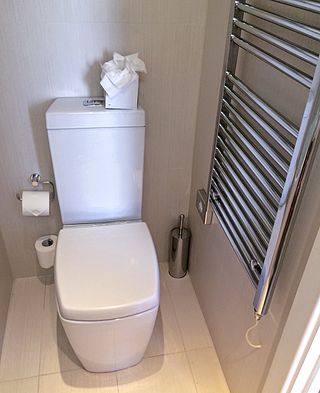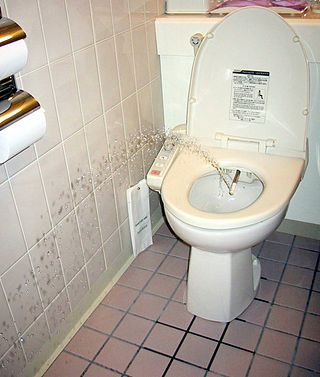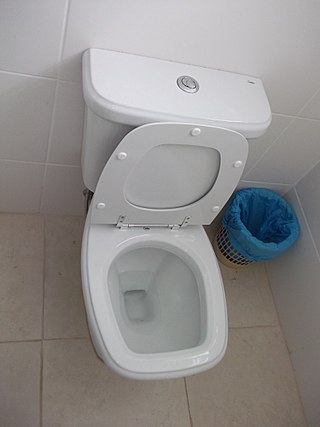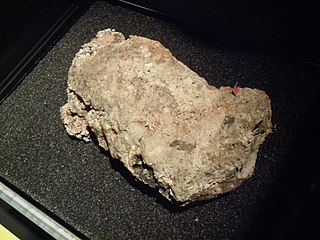An autonomous building is a building designed to be operated independently from infrastructural support services such as the electric power grid, gas grid, municipal water systems, sewage treatment systems, storm drains, communication services, and in some cases, public roads.

Greywater refers to domestic wastewater generated in households or office buildings from streams without fecal contamination, i.e., all streams except for the wastewater from toilets. Sources of greywater include sinks, showers, baths, washing machines or dishwashers. As greywater contains fewer pathogens than blackwater, it is generally safer to handle and easier to treat and reuse onsite for toilet flushing, landscape or crop irrigation, and other non-potable uses. Greywater may still have some pathogen content from laundering soiled clothing or cleaning the anal area in the shower or bath.

A flush toilet is a toilet that disposes of human waste by using the force of water to flush it through a drainpipe to another location for treatment, either nearby or at a communal facility, thus maintaining a separation between humans and their waste. Flush toilets can be designed for sitting or squatting, in the case of squat toilets. Most modern sewage treatment systems are also designed to process specially designed toilet paper. The opposite of a flush toilet is a dry toilet, which uses no water for flushing.

A sanitary sewer is an underground pipe or tunnel system for transporting sewage from houses and commercial buildings to a sewage treatment plant or disposal.

Water conservation aims to sustainably manage the natural resource of fresh water, protect the hydrosphere, and meet current and future human demand. It makes is possible to avoid water scarcity. It covers all the policies, strategies and activities to reach these aims. Population, household size and growth and affluence all affect how much water is used.

A shower is a place in which a person bathes under a spray of typically warm or hot water. Indoors, there is a drain in the floor. Most showers have temperature, spray pressure and adjustable showerhead nozzle. The simplest showers have a swivelling nozzle aiming down on the user, while more complex showers have a showerhead connected to a hose that has a mounting bracket. This allows the showerer to hold the showerhead by hand to spray the water onto different parts of their body. A shower can be installed in a small shower stall or bathtub with a plastic shower curtain or door. Showering is common due to the efficiency of using it compared with a bathtub. Its use in hygiene is, therefore, common practice.

Toilets in Japan are sometimes designed more elaborately than toilets commonly seen in other developed nations. European toilets occasionally have a separate bidet whilst Japan combines an electronic bidet with the toilet. The current state of the art for Western-style toilets in Japan is the bidet toilet, which as of March 2016 is installed in 81% of Japanese households. In Japan, these bidets are commonly called washlets, a brand name of Toto Ltd., and they may include many advanced features rarely seen outside of Asia. The basic feature set commonly found on washlets consists of anal hygiene, bidet washing, seat warming, and deodorization.

A composting toilet is a type of dry toilet that treats human waste by a biological process called composting. This process leads to the decomposition of organic matter and turns human waste into compost-like material. Composting is carried out by microorganisms under controlled aerobic conditions. Most composting toilets use no water for flushing and are therefore called "dry toilets".

A combined sewer is a type of gravity sewer with a system of pipes, tunnels, pump stations etc. to transport sewage and urban runoff together to a sewage treatment plant or disposal site. This means that during rain events, the sewage gets diluted, resulting in higher flowrates at the treatment site. Uncontaminated stormwater simply dilutes sewage, but runoff may dissolve or suspend virtually anything it contacts on roofs, streets, and storage yards. As rainfall travels over roofs and the ground, it may pick up various contaminants including soil particles and other sediment, heavy metals, organic compounds, animal waste, and oil and grease. Combined sewers may also receive dry weather drainage from landscape irrigation, construction dewatering, and washing buildings and sidewalks.

First flush is the initial surface runoff of a rainstorm. During this phase, water pollution entering storm drains in areas with high proportions of impervious surfaces is typically more concentrated compared to the remainder of the storm. Consequently, these high concentrations of urban runoff result in high levels of pollutants discharged from storm sewers to surface waters.
Water supply and sanitation in the United States involves a number of issues including water scarcity, pollution, a backlog of investment, concerns about the affordability of water for the poorest, and a rapidly retiring workforce. Increased variability and intensity of rainfall as a result of climate change is expected to produce both more severe droughts and flooding, with potentially serious consequences for water supply and for pollution from combined sewer overflows. Droughts are likely to particularly affect the 66 percent of Americans whose communities depend on surface water. As for drinking water quality, there are concerns about disinfection by-products, lead, perchlorates, PFAS and pharmaceutical substances, but generally drinking water quality in the U.S. is good.

A vacuum sewer or pneumatic sewer system is a method of transporting sewage from its source to a sewage treatment plant. It maintains a partial vacuum, with an air pressure below atmospheric pressure inside the pipe network and vacuum station collection vessel. Valves open and reseal automatically when the system is used, so differential pressure can be maintained without expending much energy pumping. A single central vacuum station can collect the wastewater of several thousand individual homes, depending on terrain and the local situation.

Water efficiency is the practice of reducing water consumption by measuring the amount of water required for a particular purpose and is proportionate to the amount of essential water used. Water efficiency differs from water conservation in that it focuses on reducing waste, not restricting use. Solutions for water efficiency not only focus on reducing the amount of potable water used but also on reducing the use of non-potable water where appropriate. It also emphasizes the influence consumers can have on water efficiency by making small behavioral changes to reduce water wastage, and by choosing more water-efficient products.

WaterSense is a program sponsored by the U.S. Environmental Protection Agency (EPA), designed to encourage water efficiency in the United States through the use of a special label on consumer products. The goal of this program is to protect the future of the U.S. water supply. WaterSense maintains partnerships with key utility, manufacturer and retail partners across the United States. WaterSense is voluntary, rather than a regulatory program. The EPA develops specifications for water-efficient products – low-flow fixtures – through a public process. If a manufacturer makes a product that meets those specifications, the product is eligible for third-party testing to ensure the stated efficiency and performance criteria have been met. If the product passes the test, the manufacturer is rewarded with the right to put the WaterSense label on that product.

Sewage treatment is a type of wastewater treatment which aims to remove contaminants from sewage to produce an effluent that is suitable to discharge to the surrounding environment or an intended reuse application, thereby preventing water pollution from raw sewage discharges. Sewage contains wastewater from households and businesses and possibly pre-treated industrial wastewater. There are a high number of sewage treatment processes to choose from. These can range from decentralized systems to large centralized systems involving a network of pipes and pump stations which convey the sewage to a treatment plant. For cities that have a combined sewer, the sewers will also carry urban runoff (stormwater) to the sewage treatment plant. Sewage treatment often involves two main stages, called primary and secondary treatment, while advanced treatment also incorporates a tertiary treatment stage with polishing processes and nutrient removal. Secondary treatment can reduce organic matter from sewage, using aerobic or anaerobic biological processes. A so-called quarternary treatment step can also be added for the removal of organic micropollutants, such as pharmaceuticals. This has been implemented in full-scale for example in Sweden.

A dual flush toilet is a variation of the flush toilet that uses two buttons or a handle mechanism to flush different amounts of water.

A flushometer is a metal water-diverter that uses an inline handle to flush tankless toilets or urinals. It was invented by William Elvis Sloan and is a product of the Sloan Valve Company.

A fatberg is a rock-like mass of waste matter in a sewer system formed by the combination of flushed non-biodegradable solids with fat, oil, and grease (FOG) deposits. The handling of FOG waste and the buildup of its deposits are a long-standing problem in waste management, with "fatberg" a more recent neologism. Fatbergs have formed in sewers worldwide, with the rise in usage of disposable cloths. Several prominent examples were discovered in the 2010s in Great Britain, their formation accelerated by aging Victorian sewers. Fatbergs are costly to remove, and they have given rise to public awareness campaigns about flushable waste.

Residential water use includes all indoor and outdoor uses of drinking quality water at single-family and multifamily dwellings. These uses include a number of defined purposes such as flushing toilets, washing clothes and dishes, showering and bathing, drinking, food preparation, watering lawns and gardens, and maintaining swimming pools. Some of these end uses are detectable while others are more difficult to gauge.
A low-flow fixture is a water saving plumbing fixture designed to achieve water savings by having a lower flow rate of water or a smaller quantity per flush. Some of these low-flow fixtures are faucets, showerheads, and toilets. In the United States a maximum water usage of conventional plumbing fixtures was federally mandated by the Energy policy act of 1992. Low-flow fixtures are designed to save water over conventional fixtures by having a lower flow rate while still maintaining satisfactory performance. The Environmental protection agency (EPA) WaterSense program has requirements for plumbing fixtures to achieve their definition for water saving low-flow.
















